
Introduction
Artificial Intelligence (AI) has revolutionized numerous industries across the globe, from healthcare and finance to transportation and entertainment. The cornerstone of this revolution lies in the development and application of various AI models. This article provides a comprehensive overview of the most advanced AI models, their capabilities, and how to use them.
Understanding AI Models
AI models are algorithms built to learn from data. They are the heart of AI systems and enable them to perform tasks that normally require human intelligence. These tasks include understanding natural language, recognizing patterns and anomalies, and making predictions.
Key Features of AI Models
AI models have several key features, including:
- Ability to learn from data and improve over time
- Capability to handle large volumes of data
- Power to make predictions based on the data they have processed
Categories of AI Models
AI models can be broadly classified into two categories:
- Supervised Models: These models are trained using labeled data. They are capable of making predictions or decisions based on past data.
- Unsupervised Models: These models learn from unlabeled data. They can identify patterns and anomalies in the data.
Top AI Models
GPT-3
Developed by OpenAI, GPT-3 (Generative Pretrained Transformer 3) is one of the most powerful language processing AI models. It has a remarkable ability to understand and generate human-like text.
BERT
BERT (Bidirectional Encoder Representations from Transformers) is a Google-developed AI model that excels in natural language understanding tasks. It’s particularly adept at understanding the context of words in sentences.
YOLO
You Only Look Once (YOLO) is a state-of-the-art, real-time object detection system. It’s incredibly fast and accurate, making it ideal for applications such as self-driving cars and surveillance systems.
How to Use These AI Models
To use these AI models, one needs a strong understanding of machine learning principles and proficiency in programming languages such as Python. However, today, various tools and platforms make it easier for even non-programmers to use AI models. They include Google’s AutoML, Microsoft’s Custom Vision, and IBM’s Watson Studio.
Conclusion
Understanding the capabilities and usage of the top AI models can help businesses and individuals harness their potential to drive innovation and solve complex problems. As AI continues to evolve, we can expect the development of more sophisticated and efficient models.


